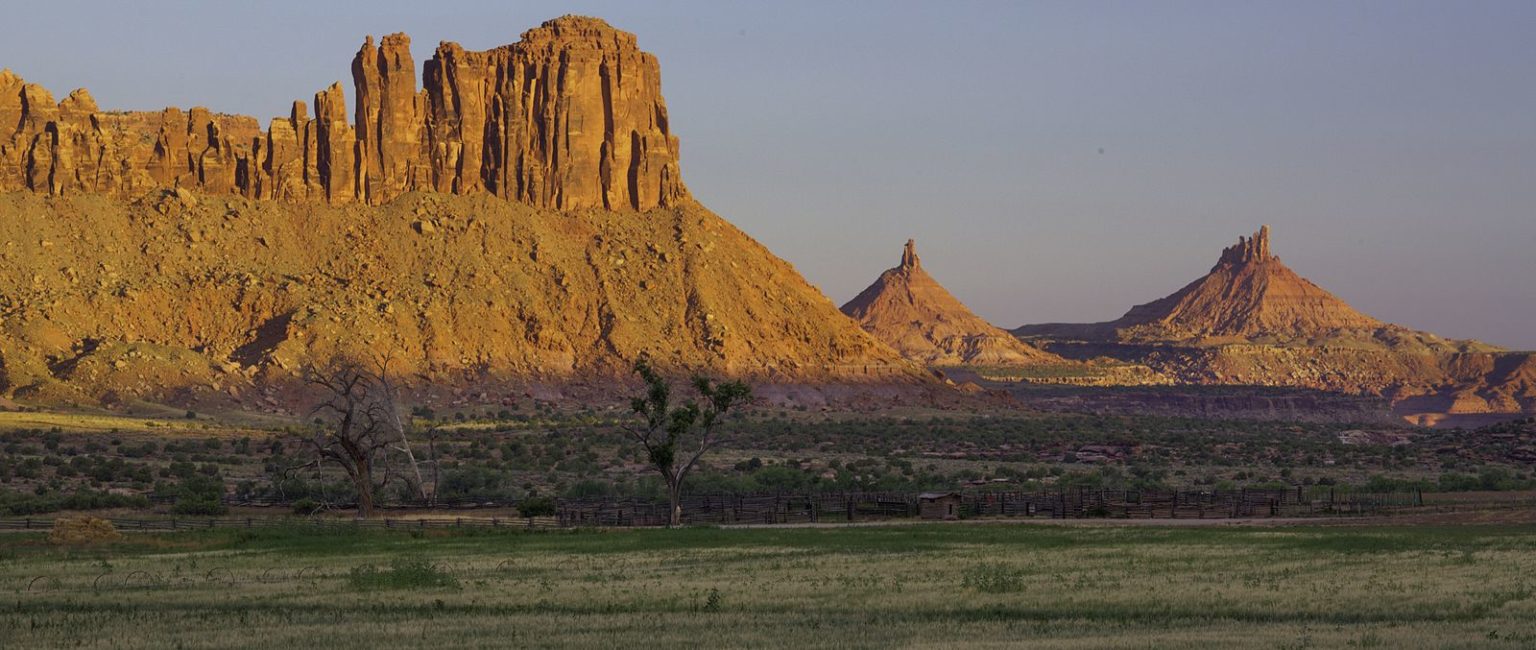Secretary of the Interior Ryan Zinke is considering revoking the protected status from Bears Ears National Monument, a culturally and archaeologically significant area spanning 1.35 million acres in Utah and protected by then-President Barack Obama under the Antiquities Act of 1906 during his last weeks in office.
While numerous Native American tribes claim ties and sacred sites within its borders, Bears Ears is also of considerable interest to the fossil fuel industry for its close proximity to oil and gas deposits, one of several reasons for pushback against the monument designation. According to a map published by WildEarth Guardians, a group calling for protection of Bears Ears, hydraulic fracturing (“fracking”) powerhouses EOG Resources and Whiting Petroleum are already drilling near the area. Soon, however, there may be much more activity.
A DeSmog review of Utah state records shows that the drilling company Wesco Operating has obtained permits to drill in oil fields near Bears Ears, fields which are part of a larger shale basin extending under the monument. Furthermore, the federal government has been stoking interest in developing that shale basin to the tune of nearly three quarters of a million dollars invested in feasibility research.
EOG, as reported by the Salt Lake Tribune in 2016, has applied to drill three exploratory wells in Bluff Bench and Chimney Rocks, both located near Bears Ears. And several other companies, including Bill Barrett Corporation, BP, Anadarko Petroleum, and Southwestern Energy, all own acreage in the Paradox Basin, the shale basin sitting under Bears Ears.
Credit: Natural Gas Intelligence: “NGI’s North American Shale & Resource Plays 2016 Factbook”
Government-Funded Research
For years, the federal government has quietly financed research on tapping fossil fuel reserves in the Paradox Basin through the Department of Energy’s Research Partnership to Secure Energy in America (RPSEA), borne out of the Energy Policy Act of 2005. Since October 2012, this research partnership program has spent more than $737,000 on an ongoing research project titled, “Liquid-Rich Shale Potential of Utah’s Uinta and Paradox Basins: Reservoir Characterization and Development Optimization.” The project is being overseen by Michael Vanden Berg, a research geologist for the Utah Geological Survey (UGS).
“[T]he UGS plans to characterize the geology of these prospective shale formations to better predict the areas, or ‘sweet spots,’ with the greatest production potential,” Vanden Berg wrote of the Paradox Basin in a May 2013 article detailing his research. “A more complete understanding of the geology and geomechanical properties of these formations will help maximize potential recoverable reserves and limit the drilling of nonproductive wells.”
Industry research collaborators on the Energy Department project included Anadarko, Southwestern Energy, Bill Barrett, Linn Energy, EOG Resources, QEP Resources, and others.
In September 2014, RPSEA hosted a conference about onshore drilling held in Salt Lake City, Utah, attended by representatives from many of the same energy companies collaborating on the research partnership and which also own acreage in the Paradox Basin. At that conference, Vanden Berg presented his team’s preliminary research findings.
The research partnership on the Paradox Basin culminated in a recently published, 178-page-long report on the potential of that basin, which includes the Cane Creek Shale field. The Cane Creek Shale field is located just north of Bears Ears.
The report concludes that, based on fluorescence microscopy imaging, this field contains the bulk of potentially the most productive areas of oil and gas contained within the Paradox Basin. Bears Ears itself, situated within San Juan County, Utah, also sits within what may turn out to be the most prolific area of the basin.
Credit: Utah Geological Survey
Cane Creek Shale Permits
One company, Fidelity Exploration & Production, has submitted 54 permits to drill in the Cane Creek Shale. The company’s applications to drill are often marked “confidential” but still published online by the Utah Division of Oil, Gas, and Mining. Fidelity is currently doing active production on 24 of those wells.
Six of those Fidelity wells, according to a January 2015 memorandum from the Utah Department of Environmental Quality, failed to comply with state’s clean air laws and the company received over $15,000 in fines as a result.
In 2016, Fidelity transferred ownership of its wells to Wesco Operating. On May 24, the Utah Division of Oil, Gas, and Mining held a hearing on Wesco’s April request to drill a horizontal well “for the production of oil and associated gas and hydrocarbons from the Cane Creek Shales” on BLM land, a request which the state has yet to sign off on though the BLM did so in May. Wesco representatives did not respond to a request for comment.
Zinke and Bears Ears
Zinke and the Interior Department have maintained publicly that they are hearing the views of all sides on Bears Ears, as the department reviews the whole slate of sites designated under the Antiquities Act, which President Donald Trump called for in an executive order in April. But GreenWire reported on May 19 that Zinke, who will hand in his recommendation to Trump on June 10, is set to endorse repealing the protected status for Bears Ears.
“Interior Secretary Ryan Zinke told local Utah officials earlier this month that he will recommend rescinding Bears Ears National Monument [to President Trump] and vowed to review public lands management more broadly, according to San Juan County Commissioner Phil Lyman,” wrote GreenWire. “Local officials as well as state and congressional Republican lawmakers have urged Trump to eliminate the Bears Ears monument located in San Juan County, arguing the Obama administration failed to sufficiently take into account opposition to the designation.”
The Interior Department denied that Zinke had come to a conclusion in a May 19 statement disseminated via Twitter.
Reports on supposed conversations that @SecretaryZinke has reached a decision on Bears Ears are not accurate. Statement -> pic.twitter.com/7LutOS20Us
— DOI PressSec (@DOIPressSec) May 19, 2017
Zinke recently traveled to Bears Ears, touring the site on horseback. While there, Zinke took a tour alongside Matt Anderson, who works as a policy analyst with the Coalition for Self-Government in the West, a project of the Sutherland Institute. Sutherland is a member of the State Policy Network, which receives funding from Koch Industries, and Koch-backed entities such as Americans for Prosperity, American Energy Alliance, Competitive Enterprise Institute, and the American Legislative Exchange Council. Sutherland spearheaded a June 1 letter, signed by many of those Koch-supported organizations, in support of amending the Antiquities Act.
“Mr. President, your executive order was a good start — but it is just a start,” reads the letter. “You have an opportunity to return power to the people, right the wrongs of the past, and set a precedent that the designations of future presidents will be subject to review.”
In his previous role as a one-term U.S. Representative for Montana, Zinke was a major recipient of campaign donations from the oil and gas industry, receiving $65,000 during his tenure. Among the donors: Western Energy Alliance, Whiting Petroleum, ExxonMobil, American Petroleum Institute, Independent Petroleum Association of America (IPAA), and others.
The Utah Legislature passed a resolution in February calling on President Trump to undo the Bears Ears Antiquities status. At the January hearing for that bill, two commissioners from Utah’s San Juan County — where Bears Ears is located — spoke in favor of its passage. Those commissioners flew to Washington, D.C. on June 5 to meet with Zinke.
Citizens, Congress Weighs In
Trump’s executive order calling for the review of all designations under the Antiquities Act allows for the public to comment and offer thoughts on the proposal. So far, the Interior Department has received over 140,000 comments online. The Center for Western Priorities, which is in favor of keeping the Bears Ears Antiquities status, did a random sample study (with a margin of error of ±4 percent) published May 25 of 500 comments generated so far and found that 96 percent of commenters showed support for national monument designations.
Credit: Center for Western Priorities
“The overwhelming support for Bears Ears should come as no surprise,” the group’s executive director Jennifer Rokala told GreenWire on May 26. “National monuments are monuments to America’s heritage and history. They’re wildly popular across the country, and Bears Ears is no exception.”
House and Senate Democratic leadership published a letter on May 25 calling to maintain the status quo on national monuments under the Antiquities Act.
“It is unconscionable to think that this administration would sell out America’s outdoor heritage to benefit corporate interests in the oil, gas, and mining industries,” they wrote. “In establishing the Antiquities Act and through its repeated use, the Congress and past Presidents recognized that there are certain places too special to be spoiled by industrial development or commercial use.”
Next Standing Rock?
Several Native American tribes have formed a coalition, called the Bears Ears Inter-Tribal Coalition, which calls for maintaining Antiquities status for Bears Ears. Writer and activist Terry Tempest Williams has gone so far to say that, if Bears Ears is taken off of the Antiquities list, a new Standing Rock-like uprising could follow, again led by Native Americans.
“Bears Ears could very well become another Standing Rock in both desecration and resistance — the latest example of a new colonialism, with the government bulldozing Indian sovereignty and privileging Big Oil,” Williams wrote on May 6 in The New York Times. “Bears Ears is a cradle of Native American history. Far from creating a ‘midnight monument’ willed into existence at the slash of a presidential pen, the Obama designation provides these sacred lands with the protection that has long been in the prayers and dreams of tribal leaders.”
Main image: Indian Creek and the Sixshooter Peaks in Bears Ears National Monument. Credit: U.S. Bureau of Land Management, public domain
Subscribe to our newsletter
Stay up to date with DeSmog news and alerts











